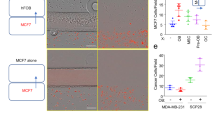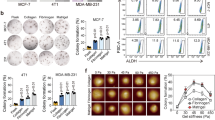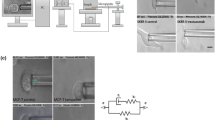Abstract
Bone morphogenetic protein 2 (BMP2) has been shown to modulate the proliferation and differentiation of breast cancer cells. However, the biochemical effects and mechanisms remain unknown. In this paper, the effects of recombinant human BMP2 on the migration of MCF-7 cells—one breast cancer cell line, using transwell and wound healing experiments, as well as on the cellular morphology, cytoskeleton, cell surface adhesion, and stiffness detected at subcellular level by an atomic force microscope, were investigated. After BMP2 treatment, the untreated round-shaped MCF-7 cells transformed to a spindle-like shape with lots of specialized structures, such as lamellipodia, filopodia, membrane protrusions, and others, which are essential for cellular migration or spreading. Moreover, flow cytometry quantitatively detected the BMP2-induced changes in the expression of adhesion molecules, a significant rise of CD44, and a remarkable drop of E-cadherin. The data indicated that BMP2 promoted the migration and invasion of MCF-7 cells by regulating the reorganization of cytoskeleton and the expression of adhesion molecules in/on the cells. Thus, it is very imperative to evaluate the oncogenicity of BMP2 when used in tissue engineering.





Similar content being viewed by others
References
Alikani M (2005) Epithelial cadherin distribution in abnormal human pre-implantation embryos. Hum Reprod 20:3369–3375
Alstergren P, Zhu BQ, Glougauer M, Tak WM, Richard P, Ellen JS (2004) Polarization and directed migration of murine neutrophils is dependent on cell surface expression of CD44. Cell Immunol 231:146–157
Cappella B, Baschieri P, Frediani C, Miccoli P, Ascoli C (1997) Force–distance curve by AFM. IEEE Eng Med Biol 16:58–65
Cross SE, Jin YS, Tondre J, Wong R, Rao JY, Gimzewski JK (2008) AFM–based analysis of human metastatic cancer cells. Nanotechnology 19:1–8
Emma LA, Kallioniemi A (2010) Bone morphogenetic proteins in breast cancer: dual role in tumourigenesis. Endocr-Relat Cancer 17:R123–R139
Frixen UH, Behrens J, Sachs M, Eberle G, Voss B, Warda A (1991) E-cadherin-mediated cell–cell adhesion prevents invasiveness of human carcinoma cells. J Cell Biol 113:173–185
Girasole M, Pompeo G, Cricenti A, Longo G, Boumis G, Bellelli A, Amiconi S (2010) The how, when, and why of the aging signals appearing on the human erythrocyte membrane: an atomic force microscopy study of surface roughness. Nanomedicine 6:760–768
Haramis APG, Begthel H, van den Born M, van Es J, Jonkheer S, Offerhaus GJA, Clevers H (2004) De novo crypt formation and juvenile polyposis on BMP inhibition in mouse intestine. Science 303:1684–1686
Hsieh CH, Lin YH, Lin S, Tsai WU JJ, WU CH, Jiang CC (2008) Surface ultrastructure and mechanical property of human chondrocyte revealed by atomic force microscopy. Osteoarthr Cartil 16:480–488
Iyer S, Gaikwad RM, Subba-Rao V, Woodworth CD, Sokolov I (2009) Atomic force microscopy detects differences in the surface brush of normal and cancerous cells. Nature Nanotech 4:389–393
Jemal A, Murray T, Ward E, Samuels A, Tiwari RC, Ghafoor A (2005) Cancer statistics. CA Cancer J Clin 55:10–30
Jin H, Huang X, Chen Y, Zhao H, Ye H, Huang F, Xing X, Cai J (2010) Photoinactivation effects of hematoporphyrin monomethyl ether on Gram-positive and -negative bacteria detected by atomic force microscopy. Appl Microbiol Biotechnol 88:761–770
Jonuleit H, Schmitt E, Schuler G, Knop J, Enk AH (2000) Induction of interleukin 10-producing, nonproliferating CD4+ T cells with regulatory properties by repetitive stimulation with allogeneic immature human dendritic cells. J Exp Med 192:1213–1222
Katsuno Y, Hanyu A, Kanda H, Ishikawa Y, Akiyama F, Iwase T, Ogata E, Ehata S, Miyazono K, Imamura T (2008) Bone morphogenetic protein signaling enhances invasion and bone metastasis of breast cancer cells through Smad pathwayBMPs induce invasion and metastasis of breast cancer cells. Oncogene 27:6322–6333
Liu Y, Wang Y, Zhang Y, Miao Y, Zhao Y, Zhang PX (2009) Abnormal expression of p120-catenin, E-cadherin, and small GTPases is significantly associated with malignant phenotype of human lung cancer. Lung Cancer 63:375–382
Nakashima M, Reddi AH (2003) The application of bone morphogenetic proteins to dental tissue engineering. Nat Biotechnol 21:1025–1032
Orian RV, Chen L, Sleeman JP, Herrlich P, Ponta H (2002) CD44 is required for two consecutive steps in HGF/c–Met signaling. Genes Dev 16:3074–3086
Orian-Rousseau V (2010) CD44, a therapeutic target for metastasising tumours. Eur J Cancer 46:1271–1277
Page CL, Puiffe ML, Meunier L, Zietarska M, Ladurantaye MD, Tonin PN (2009) BMP-2 signaling in ovarian cancer and its association with poor Prognosis. J Ovarian Res 2:1–11
Paul JK, Mark AR, Celina GK (2003) E-cadherin expression in primary carcinomas of the breast and its distant metastases. Breast Cancer Res 5:R217–R222
Piccirillo SGM, Reynolds BA, Zanetti N, Lamorte G, Binda E, Broggi G, Brem H, Olivi A, Dimeco F, Vescovi AL (2006) Bone morphogenetic proteins inhibit the tumorigenic potential of human brain tumour-initiating cells. Nature 444:761–765
Ponta H, Sherman L, Herrlich PA (2003) CD44: from adhesion molecules to signalling regulators. Nat Rev Mol Cell Biol 4:33–45
Prass M, Jacobson K, Mogilner A, Radmacher M (2006) Direct measurement of the lamellipodial protrusive force in a migrating cell. J Cell Biol 174:767–772
Qian Y, Zhong XS, Flynn DC, Zheng JZ, Qiao M, Wu CY (2005) ILK mediates actin filament rearrangements and cell migration and invasion through PI3K/Akt/Rac1 signaling. Oncogene 24(19):3154–3165
Revenu C, Athman R, Robine S, Louvard D (2004) The co-workers of actin filaments: from cell structures to signals. Nat Rev Mol Cell Bio 5:635–646
Rodriguez OC, Schaefer AW, Mandato CA, Forscher P, William MB, Clare MW (2003) Conserved microtubule–actin interactions in cell movement and morphogenesis. Nat Cell Biol 5:599–609
Schmalhofer O, Brabletz S, Thomas B (2009) E-cadherin, β-catenin, and ZEB1 in malignant progression of cancer. Cancer Metast Rev 28:151–166
Suresh S (2007) Nanomedicine: elastic clues in cancer detection. Nat Nanotechnol 2:748–749
Tariq B, Tabish M, Ahmad H, Rosenthal PB, Khan S, Khan S (2010) Myosin motors drive long range alignment of actin filaments. J Biol Chem 285:4964–4974
Vignjevic D, Montagnac G (2008) Reorganisation of the dendritic actin network during cancer cell migration and invasion. Semin Cancer Biol 18:12–22
Wu G, Liu Y, Iizuka T, Hunziker EB (2010) The effect of a slow mode of BMP-2 delivery on the inflammatory response provoked by bone-defect-filling polymeric scaffolds. Biomaterials 31:7485–7493
Zetter BR (1993) Adhesion molecules in tumor metastasis. Semin Cancer Biol 4:219–229
Acknowledgments
We express our thanks to Prof. Guanqun Yang (The First Affiliated Hospital, Jinan University, China) for their help and hot discussion. This work was funded by the National Natural Science Foundation of China (30900340), 973 program projects (2010CB833603), and China postdoctoral foundation (20090450099, 201003359).
Author information
Authors and Affiliations
Corresponding authors
Rights and permissions
About this article
Cite this article
Jin, H., Pi, J., Huang, X. et al. BMP2 promotes migration and invasion of breast cancer cells via cytoskeletal reorganization and adhesion decrease: an AFM investigation. Appl Microbiol Biotechnol 93, 1715–1723 (2012). https://doi.org/10.1007/s00253-011-3865-3
Received:
Revised:
Accepted:
Published:
Issue Date:
DOI: https://doi.org/10.1007/s00253-011-3865-3




